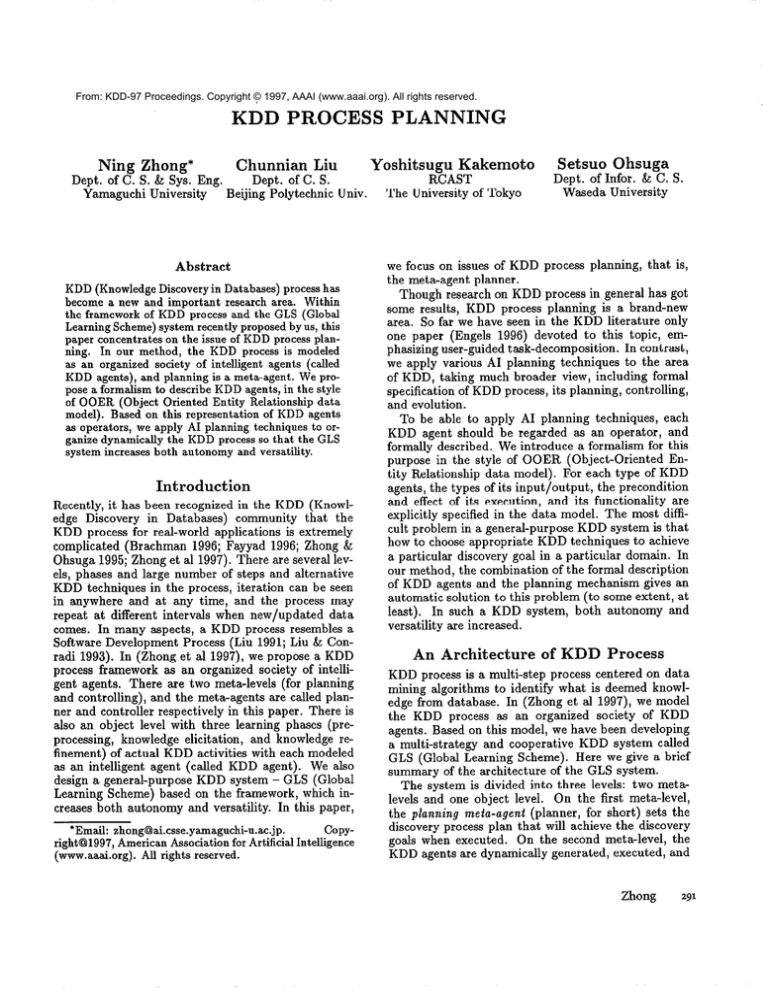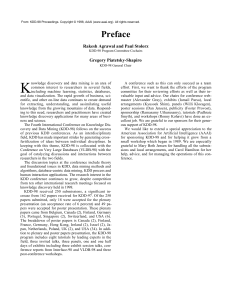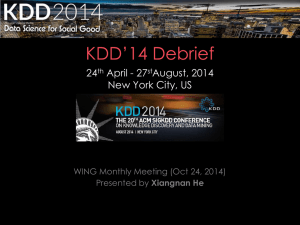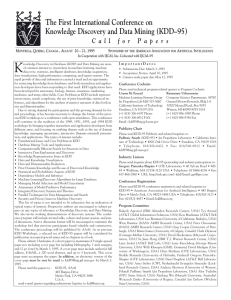
From: KDD-97 Proceedings. Copyright © 1997, AAAI (www.aaai.org). All rights reserved.
KDD
Ning
Zhong*
PROCESS
C hunnian
Liu
Dept. of C. S. & SYS. EnE.
Dept. of C. S.
qamaguchi University - Beijing-Polytechnic
Univ.
Abstract
KDD (Knowledge Discovery in Databases) process has
become a new and important research area. Within
the framework of KDD process and the GLS (Global
Learning Scheme) system recently proposed by us, this
paper concentrates on the issue of KDD process planning. In our method, the KDD process is modeled
as an organized society of intelligent agents (called
KDD agents), and planning is a meta-agent. We propose a formalism to describe KDD agents, in the style
of OOER (Object Oriented Entity Relationship data
model). Based on this representation of KDD agents
as operators, we apply AI planning techniques to organize dynamically the KDD process so that the GLS
system increases both autonomy and versatility.
Introduction
Recently, it has been recognized in the KDD (Knowledge Discovery in Databases) community
that the
KDD process for real-world applications is extremely
complicated (Brachman 1996; Fayyad 1996; Zhong &
Ohsuga 1995; Zhong et al 1997). There are several levels, phases and large number of steps and alternative
KDD techniques in the process, iteration can be seen
in anywhere and at any time, and the process may
repeat at different intervals when new/updated data
comes. In many aspects, a KDD process resembles a
Software Development Process (Liu 1991; Liu & Conradi 1993). In (Zhong et al 1997), we propose a KDD
process framework as an organized society of intelligent agents. There are two meta-levels (for planning
and controlling), and the meta-agents are called planner and controller respectively in this paper. There is
.x1,,
CUU”
om
au
nh:,,+
““JGb”
l,..,l
IGYcjl
. . ..+h
““IUII
th,,,
“IIIc;C
lz,.xmn;nm
I.xuIIIu~
,hm,o
yucw~u
Inr,z
\y’b-
processing, knowledge elicitation, and knowledge refinement) of actual KDD activities with each modeled
as an intelligent agent (called KDD agent). We also
design a general-purpose KDD system - GLS (Global
Learning Scheme) based on the framework, which increases both autonomy and versatility. In this paper,
‘Email: zhongOai.csse.yamaguchi-u.ac.jp.
right01997, American Association for Artificial
(www.aaai.org).
All rights reserved.
COPY-
Intelligence
PLANNING
Kakemoto
Setsuo Ohsuga
Rt AST
The University of Tokyo
Dept. of Infor. &?.
Waseda University
Yoshitsueru
S.
we focus on issues of KDD process planning, that is,
the meta-agent planner.
Though research on KDD process in general has got
some results, KDD process planning is a brand-new
area. So far we have seen in the KDD literature only
one paper (Engels 1996) devoted to this topic, emphasizing user-guided task-decomposition.
In contrast,
we apply various AI planning techniques to the area
of KDD, taking much broader view, including formal
specification of KDD process, its planning, controlling,
and evolution.
To be able to apply AI planning techniques, each
KDD agent should be regarded as an operator, and
formally described. We introduce a formalism for this
purpose in the style of OOER (Object-Oriented
Entity Relationship data model). For each type of KDD
agents, the types of its input/output,
the precondition
and effect of its execution, and its functionality
are
explicitly specified in the data model. The most difficult problem in a general-purpose KDD system is that
how to choose appropriate KDD techniques to achieve
a particular discovery goal in a particular domain. In
our method, the combination of the formal description
of KDD agents and the planning mechanism gives an
automatic solution to this problem (to some extent, at
least). In such a KDD system, both autonomy and
versatility are increased.
An Architecture
of KDD
Process
KDD process is a multi-step process centered on data
mining algorithms to identify what is deemed knowledge from database. In (Zhong et al 1997), we model
the KDD process as an organized society of KDD
agents. Based on this modei, we have been deveioping
a multi-strategy and cooperative KDD system called
GLS (Global Learning Scheme). Here we give a brief
summary of the architecture of the GLS system.
The system is divided into three levels: two metalevels and one object level. On the first meta-level,
the planning meta-agent (planner, for short) sets the
discovery process plan that will achieve the discovery
goals when executed. On the second meta-level, the
KDD agents are dynamically generated, executed, and
Zhong
291
controlled by the controlling meta-agent (controller,for
short). Planning and controlling dynamically the discovery process is a key component to increase both
autonomy and versatility of our system. On the object
level, the KDD agents are grouped into three learning
phases:
Pre-processing agents include: agents to collect information from global information sources to generate
a central large database; agents to clean the data; and
agents to decompose the large database into several local information sources (subdatabases), such as CBK
(attribute oriented clustering using background knowledge), QDR (q uantkation by the division of ranges),
FSN (forming scopes/clusters by nominal or symbolic
attributes), and SCT (stepwise Chow test to discover
structure changes in time-series data).
Knowledge-elicitation
agents include: agents such as
KOSI (knowledge oriented statistic inference for discovering structural characteristics - regression models), DBI (decomposition based induction for discovering concept clusters), and GGDT (generalizationdistribution-table
based generalization for discovering
if-then rules).
Knowledge-refinement
agents acquire more accurate
CleanData from the central large database, SelectedData (Scope or Cluster) from the subdatabases, and
so on. On the knowledge part, we first distinguish
among Kdomain (the background knowledge), Kdiscovered (the discovered knowledge) and Krefined (the
~~~~!~~w o-
refined
fhvnot,hesis\
\--J r - --- ----,
frnm
-- - --- C.Q~TS~ knowje@e
@y-
pothesis) according to data change and/or the domain
knowledge. KDD agents such as IIBR (inheritanceinference based refinement) and HML (hierarchical
model learning) are commonly used for this purpose.
In terms of AI planning, no matter how many KDD
agents we have, each of them is an operator. Each operator by itself can only do some simple thing, only
when they are organized into a society, we can accomplish more complex discovery tasks. The KDD planner
reasons on these operators to build KDD process plans
- networks of KDD agents that will achieve the overall
discovery goals when executed. But to apply AI planning techniques, we must be able to formally describe
the KDD agents as operators. This is the subject of
the next section.
Formal
Description
of KDD
Agents
The KDD planner, as any AI planner, needs a World
State Description (WSD) and a pool of Operators
(0~s).
We use the OOER (Object-Oriented
Entity
Relationship) data model to describe them. The traditional ER model has concepts of entity/relation,
type/instance,
instance-level attributes, and so on.
The OOER model further incorporates object-oriented
concepts such as subtyping, multiple inheritance, procedures, and type-level attributes/procedures,
and so
on. There are two kinds of types, D&‘ii’ types and
Agent types, for passive and active objects respectively.
Figure 1 shows the (simplified) type hierarchy used in
the GLS system:
The D&K types describe various data and knowledge presented in a KDD system. On the data part,
we have RawData from the global information source,
292
KDD-97
Figure 1: The type hierarchy of the GLS system
Imnwied_ge)i
The
type
Kdisconered
__...
-__ _ -. -.. h&3 SlJh-
types: Regression (structural characteristics),
CCluster (conceptual clusters), Rule (if-then rules), Clause
(predicate definitions), and so on. Krefined has subtypes RegreTbee (family of regression models) and so
on.
The Agent types describe various KDD techniques
We distinguish Autoused in the GLS system.
matic (KDD algorithms) from Interactor (KDD techKdiscover
niques that need human assistance).
means the overall KDD task, while Preprocess, Kelicit and KreJine stand for the three learning phases:
pre-processing, knowledge-elicitation,
and knowledgerefinement, respectively. Collect, Clean and Select are
activities in Preprocess. Most agent types take the
same technical names as mentioned above, such as
CBK, QDR, FSN, SCT, KOSI, DBI, GGDT, IIBR,
HML.
Note that in Figure 1, we show only the subtype
relations among KDD objects (a subtype is-a special
case of the supertype). For example, all of Kdiscover,
Preprocess, Kelicit, Krefine are subtypes of Interactor,
We will see below how to express the subagent relation,
for example, Preprocess, Kelicit, Krejhe are three subagents of Kdiscover.
Types have the ordinary instance-level attributes.
For example, D&K has the attribute status describing
the current processing status of the datajknowiedge
(created, cleaned, reviewed, stored, etc.), and this attribute is inherited by all subtypes of D&K, Kdiscovered has the attribute timestamps recording the time
when the knowledge is discovered, and this attribute
is inherited by all subtypes of Kdiscover (Regression,
CCluster, Rule, and Clause).
r-l
As for Agent types, there are additional properties
defined. For example, we may have type/instance-level
nl.cnf-.a
Arvna
~vnwa~;nm
yrv\ruuuruu
U~tJ’““Ulll~ nn,mat.;nm
“y”.cu”~“YY nn
V.I t.hm
YII” t.vnea
“J y-A.. or instances (creation, deletion, modification, etc.). However, the most interesting properties of Agent types
are the following type-level attributes with information
that is used by the planning meta-agent:
The pool of
Operators
flhe Tvnes
\...-ar-- of
--
IPlan
Y
Discovered/
Relined
Knowledge
In/Out:
specifying the types of the input/output
of an agent type.
The specified types are some
subtypes of D&K, and the types of the actual input/output
of any instance of the agent type must
be subtypes of the specified types.
Precond/Effect:
specifying the preconditions for an
agent (an instance of the agent iypej to execute,
and the effects when executed. Precond/Effect are
logic formulas with the restrictions as in the classical
STRIPS (see (Russell 1995), for example). A large
part of the Precond/Effect,
concerning constraints
on input/output
of the agent type, has been specified implicitly by the In/Out attribute. At planning
time, the In/Out specification will be transformed
into conjunctions of literals, then added to the Precond/Effect on which the planner reasons.
Action: a sequential program performing real KDD
actions upon agent execution, e.g. to call the underlying KDD algorithms. It is empty for high-level
agents.
Decomp: describing possible subtasking. High-level
agents are allowed and should be decomposed into
a network of subagents. Decomp specifies the candidate agent types for the subagents. For example,
the Decomp for agent type Kdiscover is: Preprocess,
Kelicit, Icrefine. Next section will explain how the
hierarchical planning utilizes this property to realize
the task decomposition.
Figure 2: Coupling
meta-agents
Hierarchical
Process
Planning
The planning meta-agent (the planner) has three layers as shown in Figure 2. The inner layer is a domainindependent non-linear planner, the middle layer deals
with KDD-specific issues, and the out layer interacts
with another meta-agent, the controller, to realize hierarchical planning.
In the following subsections we
will discuss these three layers separately, and give an
example of KDD process planning.
Non-Linear
Pianning
The inner layer as shown in Figure 2 is a domainGiven the initial
independent non-linear planner.
world state, the discovery goal and the pool of operators (KDD agents), it starts with a dummy partial plan (Russell 1995), then expands the partial plan
until finds a complete and consistent plan that solves
the problem. The process can be implemented by a
production system (Liu 1991), or a nondeterministic
algorithm (Russell 1995).
of the planning
and controlling
Planning
As we are deaiing with reai worid KDD appiicaiions,
a hierarchy of abstractions is essential. The process
of alternatively adding detailed steps to the plan and
actually executing some steps should continue until the
goal is achieved. In GLS, this hierarchical planning
is accomplished by the cooperation of the two metaagents - planner and controller. The interface between
them is the outer layer of Figure 2. The two metaagents interact as follows.
At the beginning, the controller generates a highlevel KDD agent HA (K&cover, for example) with the
,-I;PF~,,PIv
uIuLu*.AJ
KDD
I
annl SE
6”cuL
w ;t.z
IVY pffppt.
“L&U”“.
‘AA&&V
This h.“‘o’”
.&,&
n.crent, HA
“d-A-”
----
CR,n
--- he
- -
regarded as the first coarse plan. When the controller
tries to execute HA, it calls the planner to decompose
it into a more detailed subplan. The planner works as
described in the above subsection, taking the current
world state as its initial-state, the effect of HA as its
goal, and searching the types of subagents specified in
the DECOMP attribute of HA, instead of the whole
pool of operators, to achieve the goal. The produced
subplan is added to the original plan, with each node
linked to HA by a subagent relationship.
Then the
controller resumes its work (generating, executing, and
controlling KDD agents according to the dpianj.
Obviously this mechanism can work in multi-levels:
if the controller meets another high-level agent when
it executes the subplan, it will call the planner again.
KDD
Specific Issues
Because the core of the planner is domain-independent,
we provide a middle layer as shown in Figure 2 to deal
with all KDD specific issues:
Zhong
293
Conclusions
Figure 3: A sample KDD process plan
1. To transform the KDD goals into STRIPS goals
(logic formulas in the style of STRIPS, that is, conjunctions of literals), especially to translate the input/output
constraints specified in the In/Out, at..
tribute
into PrecondjEffect.
2. To search the pool of operators
(or more exactly, to
search the types of subagents specified in the DECOMP attribute of a high level agent HA in the
decomposition process) to introduce suitable KDD
agents into the plan.
3. To consult the world state description
to see if a precondition is already satisfied by the WSD, and/or
help to transform the In/Out specification into conjunction of literals as part of Precond/Effect.
4. To represent, the resulting plan as a network of KDD
agents, so the controller can dynamically generate
and execute the KDD agents according to the netwnrlr
VI-**..
Thea
A**” n~twnrk
*.YY,.v**.
,-can
aim
“_I ho
“V -*“v
the GLS system as a visualization
me,4
U”“U
hv
“J t.hn
Y-l” IIEPI.
UYYI nf
v*
tool.
An Example
Assume that we have a central, large space science
database, each record (tuple) describing a star. The
interesting attributes inciude CD (cluster designationj,
ET (effective temperature), LU (luminosity), B-V and
U-B (color indexes). The facts such as we have already
had a central, large database with CleanData, and the
nominal attribute CD can be used for forming Scopes,
etc. are explicitly stated in the initial-state (WSD).
The discovery goal is to find structural characteristics
hidden in the database and to refine them upon data
change. Based on the specifications of WSD, goal, and
KDD agent, types, the planner and the controller cooperate in the manner as described above, and come
up with a full KDD process plan as shown in Figure 3.
294
KDD-97
As the KDD process for real-world applications is extremely complicated, it has become a new and important research area, in addition to the traditional
study on individual KDD techniques. In this paper,
following our framework of KDD process and within
the GLS system, we discussed in detail one of the
meta-agents in GLS, the KDD process planning. We
proposed a formalism to describe KDD agents, in the
style of OOER (Object Oriented Entity Relationship
data model). Based on this representation of KDD
agents as operators, we apply several AI planning techniques: non-linear planning (partial-order planning) as
the basic reasoning mechanism; hierarchical planning
(task-decomposition)
to tackle the complexity of KDD
process; and repianning (or integration of pianning and
execution) to support data/knowledge/process
evolution. The GLS system, as a general-purpose KDD system based on the framework and using the planning
mechanism, increases both autonomy and versatility.
References
Brachman, R.J. and Anand, T. 1996. “The Process of
Knowledge Discovery in Databases: A Human-Centered
Approach”,
in Advances in Knowledge Discovery and
Data Mdnkng, MIT Press, 37-58.
Fayyad, U.M., Piatetsky-Shapiro,
G, and Smyth, P.
1996. ‘From Data Mining to Knowledge Discovery: an
Overview”, in Advances in Knowledge Discovery and Data
Ma’ndng, MIT Press, l-36.
Liiq C, 1991, “Software Process Planninn and Fxecution: Coupling vs. Integration”,
Proc. the 3rd International Conjerence on Advanced Information
Systems
(CAiSE91), LNCS 498, Springer, 356-374.
ReplanLiu, c. and Conradi, R. 1993. ‘(Automatic
ning of Task Networks for Process Evolution in EPOS”,
Proc. the 4th European Software Engineering Conference
(ESEC’93), LNCS 717, Springer, 437-450.
Minsky, M. 1986. The Society of Mind, Simon and Schuster.
Russell, S.J. and Norvig, P. 1995. Artificial
Intelligence A Modern Approach Prentice Hall, Inc.
Tasks for Knowledge DisEngels, R. 1996. “Planning
covery in Databases - Performing
Task-Oriented
UserGuidance”, Proc. Second Inter. Conf. on Knowledge Discovery and Data Mining (KDD-96), AAAI Press, 170-175.
Se 1995. “Tnwarrl
Mm1t.L
Zhong, N. al?d Qhsnga,
.&-.,-***A ..&...“_
Strategy and Cooperative Discovery System”, Proc. First
Inter. Conf. on Knowledge Discovery and Data Mining
(KDD-95), AAAI Press, 337-342.
Zhong, N., Kakemoto, Y., and Ohsuga, S. 1997. “An
Organized Society of Autonomous
Knowledge Discovery Agents”, Proc. First Inter. Workshop on Cooperative Information
Agents - DAI meets Database Systems
(CIA’97), LNAI 1202, Springer, 183-194.
Zytkow, J.M. 1993. ‘Introduction:
Cognitive Autonomy
in Machine Discovery”, Machine Learning, KAP, 12(1-3)
7-16.





